Update May 9: added the news that Boeing was aware of the failure of the ‘AOA Disagree alert’ signal in the cockpit if the airline did not purchase the ‘AOA indications’ option.
Update June 7: Boeing wanted to wait three years to fix safety alert on 737 Max (LA Times)
———————————————————————————-
Boeing made many mistakes during the design process of the Boeing 737 MAX series aircraft. The MAX series is the successor of the NG (Next Generation) series of Boeing 737.
But also after Boeing found out of issues related to the first crash of aircraft, it did not take action.
As a result of these mistakes and neglect two brandnew Boeing 737 MAX aircraft crashed in the same phase of the flight under similar conditions killing 346 people. The Boeing Company issued an apology and, for the first time, acknowledged its automatic flight control system (Maneuver Characteristics Augmentation System or MCAS) played a role in the two plane crashes.
This Seattle Times article explains very well why Boeing decided to upgrade an old airframe.
MCAS is software running on the Flight Control Computer (FCC). A Boeing 737 has two FCC’s made by Collins. Each FCC receives input from a single AOA-sensor.
Boeing in a press release stated
A pitch augmentation control law (MCAS) was implemented on the 737 MAX to improve aircraft handling characteristics and decrease pitch-up tendency at elevated angles of attack. It was put through flight testing as part of the certification process prior to the airplane entering service. MCAS does not control the airplane in normal flight; it improves the behavior of the airplane in a non-normal part of the operating envelope.
This is wrong! MCAS software hardly evaluates if the aircraft is operating in what Boeing calls ‘non-normal part of the operating envelope’. This blog will show MCAS activates basically on the value of one sensor; the AOA-sensor which was damaged seconds after takeoff.
Bloomberg did investigation on cases where the AOA-sensor of an aircraft failed.
USA Today reports about the Boeing response to the question why MCAS is only using the data of a single sensor.
The company felt safe in adding MCAS because if there was a malfunction, “a pilot would be able to counteract erroneous system input” utilizing either of two methods, Pedraza sai
That is a remarkable statement, as Boeing did not inform the crews about MCAS. How should a crew unaware of MCAS and what is does, be able to analyse an issue?
A reason for using just a single sensor could be because MCAS is not essential for flight safety. Its main purpose is to make sure the MAX response the same as the NG series. However the designers did not think about the huge autonomy of MCAS being able to nose dive the aircraft.
Before MCAS, Boeing 737 aircraft had a similar feature called Speed Trim system (STS). This system also modifies the stabilizer position during manual flight (good info here). Like MCAS, it was brought in to improve stability under certain flight conditions. The purpose of the STS is to return the airplane to a trimmed speed by commanding the stabilizer in a direction opposite the speed change. STS operates ina different flight envelope region than MCAS so the two do not interfere. A demo of STS can be seen here.
MCAS and Speed Trim System are both commands from the “autopilot”.
MCAS will command Aircraft Nose Down commands 5 seconds after the last manual electric trim commanded via the switches on the yoke.
MCAS was required by the FAA for certification reasons. The software is needed because the newer engines on the MAX provide some unwanted additional lift under certain circumstances. Boeing faced a similar challenge for the Boeing 737-300 and later series. This article explains the reason for the ‘hamster mouth’ shaped engines.
Boeing had to redesign many aspects of the MAX to be compliant with the NG series so pilots did not need (expensive) simulator training and new certifications. This post on airliners.net has a very good reconstruction of how the decisions at Boeing could be explained.
According a April 8 article of the New York Times, Mike Renzelmann, an engineer who worked on the Max’s flight controls said
“They wanted to A, save money and B, to minimize the certification and flight-test co. “Any changes are going to require recertification.”
For some basic information on the horizontal stabilizer and how to act on a runaway stabilizer New York Times published a great article.
At May 5 Australian television ’60 Minutes Australia’ broadcasted an episode on the Boeing 737 MAX failures. Pilots, experts were interviewed. The episode is called ‘Rogue Boeing 737 Max planes ‘with minds of their own’ | 60 Minutes Australia’.
This is an overview of the failures by Boeing which resulted in the death of 346 people.
- Pushing an ageing design past its limits. Build an new aircraft with new, larger engines, on an airframe which is 50 years old instead of design a totally new aircraft using fly by wire.
As a result of using the larger, fuel efficient engines, the landinggear had to be adjusted. More important, the engine position was moved more forward and higher to make sure there is enough space between ground and engine. However the engines could cause additional lift which could lead to a stall.
A certification requirement is to ensure the control column force required to increase pitch does not decrease at high angles of attack. This is the reason MCAS was developed. MCAS lowers the nose automatically in certain conditions.- Rush the design of the Boeing 737 MAX as Airbus was ahead on the development of the Airbus A320neo. Boeing customers like American Airlines expressed interest in acquiring the Airbus.
- Find out during test flights the aerodynamic effects caused by the engines resulting in a possible stall are much higher than calculated. Fix it by making MCAS more powerfull than initially designed. (from 0.6 degrees per actuation to 2.5 degrees)
- Do not inform the FAA about how exactly MCAS functions. “As a new device on an amended type certificate, we retained the oversight [of MCAS],” FAA acting administrator Dan Elwell told a Senate hearing March 27. As the organization designation authorization process for the MAX was refined “under very strict review,” MCAS was among the items shifted to the manufacturer.
- Do not inform FAA about making MCAS more powerfull than initially designed. Initially MCAS was able to make 0.6 degree max deflection but this was changed at flighttesing to a 2.5 degree. People within the FAA have claimed that the system was certified based on 0.6 deg, and that was passed on to international bodies. Also the claim is the FAA did not to know about the increase until after the LionAir crash. (Seattle Times)
- Certify the plane by Boeing staff because FAA agrees to do so. This prevented a neutral, non-commecial look at the design and created a ‘cost cutting’ culture having more priority over a ‘safety first’ culture.
- Boeing used the marketing statement “pilots flying the MAX which are trained on the 737 NG series do not require simulator training” as a design requirement for the MAX. All the update training for a pilot to fly a MAX is just 1 hour on an iPad, says FAA and Boeing
- Boeing signed a contract selling Boeing 737 MAX aircraft to launching customer Southwest Airlines. Media report that “Boeing had committed to paying Southwest Airlines $1 million per plane if the 737 MAX ended up requiring pilots to spend more time training on simulators.”. This put even more pressure on the design team.
- Have MCAS use data of just a single Angle of attack sensor. If the sensor provides faulty data, MCAS will be triggered while it should not . A Boeing 737 MAX has two AOA-sensors attached on the left and righthand side of the fuselage near the cockpit.
One of the reasons why just a single sensor is used by MCAS is that this is the default architecture for a Boeing 737 with each FCC using only the sensors wired to that unit.
Another possible reason could be Boeing decided to use just a single sensor as in certain conditions both AOA-sensors provide different data, like in a turn. AOA-sensors can fail due to icing or birdstrikes. Seattle Times quotes Rick Ludtke, a former Boeing engineer who worked on designing the interfaces on the MAX’s flight deck. He said that if the group had built the MCAS in a way that would depend on two sensors, and would shut the system off if one fails, he thinks the company would have needed to install an alert in the cockpit to make the pilots aware that the safety system was off. And if that happens, Ludtke said, the pilots would potentially need training on the new alert and the underlying system. That could mean simulator time, which was off the table.AOA-sensors do fail. Southwest replaced two AOA-sensors just after the Lion Air crash. There are known failures as a result of bird strikes and icing.
Another reaso told by a whistleblower is that if Boeing decided to use two sensors, the FAA would require to have level D training for certification of the aircraft.
Peter Lemme writes on Twitter If the AOA (alpha) vane falls off, the internal counterweight would orient the vane like a pendulum. It drags the nose down (positive alpha) under 1g, and the opposite in negative g. That is exactly what happens.
One of the major questions is: why did the AOA-sensors of both Lion Air and Ethiopian Airlines fail? Investigators say there was no bird-strike at take-off of ET302. Why did the sensor have faulty data?- Enabling MCAS to be reset. MCAS makes adjustments to the stabilizer as long as the AOA is above a value. The adjustment is an increment lasting 10 seconds. However, after the pilot performs a manual trim, MCAS is reset. The next time MCAS activates, it will again be active for 10 seconds moving aircraft nose down. (source)
- Make MCAS authoritive (extraordinary power because of unlimited elevator authority ) in handling the movements of the nose. Over several minutes, the stabilizer can, command by MCAS, shift position enough that the elevator controls (controled by the pilot by pulling/pushing the yoke) can no longer counteract the downward direction of the plane.
This is likely caused because MCAS uses the high speed mode of the stabilizer trim motor while manual elec trim uses the slower mode. On the Boeing 737 NG in a flaps up, autopilot disengaged situation, manual electric trim has a speed of 0,2 units per second. This is the situation MCAS can be active. The trimspeed for the MAX is unknown.MCAS on the Ethiopian flight did 0,27 units per second AND.- Do not create new procedures for handling failure cases of MCAS. Instead maintain current procedures as on the NG-series so additional training is not required (for example disable MCAS by using electric trim cutout switches) . Boeing failed to explain that by using the trim switches on the yoke with less than 5 seconds pauze, MCAS would not be activated. So by using the yoke switches, the aircraft could be trimmed. Once trimmed, the cutout switches should be set to OFF.
- Do not inform the crews about MCAS in manuals. MCAS as not mentioned in any manual (like Flight Crew Operating Manual ) . An American Airlines flight manual mentions MCAS only in a table of acronyms, according to an October 2018 edition of the 1,400-page book seen by Reuters.
“After many scenarios and flights in all regimes, there was a consensus by the flight standardization board (FSB), made up of 737NG pilots from carriers around the world,that there was no marked difference in the handling characteristics of these two aircraft,” according the FAA. This was the primary reason that more information on MCAS was not provided to pilots. (source).Boeing, relying on the FSB feedback and the concept that MCAS was an expansion of the 737NG speed-trim system (STS) and not a standalone addition to the design, did not include MCAS-related training in the 737 MAX documentation.- Do not inform crew in pilot that MCAS is activated using for instance the instruments.
- Do not limit the activation of MCAS to a limited number of conditions which makes sense for a need for aircraft nose down. Just three conditions must be true to activate MCAS: autopilot off, flaps retracted and AOA-sensor data above a certain value. Better would be if MCAS consider extra data like altitude, speed and force on the yoke and use margins.For example, on the ET302 flight MCAS was activated just before the impact as the crew decided to put the cutoff switches for the electric stabilizer to ON-posistion again. The speed of the aircraft at that time was well above a value for which a stall can happen. The highest speed one might expect MCAS is about 270 knots (highest stall speed of about 190 knots * 1.41 or 2g). Taken from the preliminary report:
The left indicated airspeed increased from approximately 305 kt to approximately 340 kt (VMO). The right indicated airspeed was approximately 20-25 kt higher than the left.
At 05:41:20, the right overspeed clacker was recorded on CVR. It remained active until the end of the recording.
VMO = maximum operating limit speed. As the left AOA-sensor gave incorrect data, the IAS on the rightside seems correct. Around 370 knots IAS is well above the 270 knots which could be a threshold for MCAS-activation.
So it did not make ANY sense to activate MCAS. See this post of Peter Lemme.Additionaly, an AOA-value of 74,5 degreess does not make sense either. The display in tje cockpit which shows the AOA-angle (which is a paid option btw) has a range of -6 to 21 degrees. So 74,5 is seen as invalid by the instrument. However MCAS was activated by the value of 74,5 degrees (which was reached in a split second, which should be another indication for a vault)
- No adjustment of the authority of MCAS depending on the situation the flight is in. In the last phase of the flight, the aircraft flew at a high speed. Dynamic pressures, which governs how the aircraft reacts to control surface movements, is now almost double it was when previous MCAS trimmed (Dynamic pressure increases with Speed squared). The aircraft was at a low altitude. However MCAS commanded a huge aircraft nose down (AND) from 2.3 to 1.0 unit.
Taken from the preliminary report
At 05:43:20, approximately five seconds after the last manual electric trim input, an AND automatic trim command occurred, and the stabilizer moved in the AND direction from 2.3 to 1.0 unit in approximately 5 seconds.As a result of this final MCAS command the aircraft could not be saved.- Not excluding non-possible scenario’s like AOA-data which changes from 0 to almost 75 degrees in a split second. Never a plane will be able to reach such a AOA. A simple line of code checking this could save many lives.
A cross check using other values, such as static and total pressures, vertical speed, pitch angle, acceleration, or even cross check with the second AOA-sensor would prevent crashes.The image below shows the flight data recorder data of ET302. At the ‘AOA Divergence’ label the red line representing the left AOA-sensor all of a sudden climbs to 75 degrees (scale not visible) while the right AOA-sensor has normal values for takeoff.This 75 degrees does not match with a vertical rate of climb which validates the 75 degrees. 75 degrees is impossible anyway.
- Remove the ‘Angle of Attack disagreement alert’ option which was available on the Boeing 737 models previous to the MAX. And make function an ‘extra’ which needs to be paid for (see point 20) (Wall Street Journal)
- Do not inform airlines the ‘AOA disagreement alert ‘ has been removed from the Boeing 737 MAX. Also the FAA was not aware Boeing deleted this safety feature (Wall Street Journal)
- Charge for a warning light ($18,000) on the pilot display which warns pilots of an AOA disagree between the left and right AOA-sensors. Boeing will now offer this for free.
The AOA-sensor data is used to calculate IAS (speed) as well as altitude. When on of the AOA-sensors fail, erroneous IAS will be shown on the side where the AOA-sensor failed.
However, the crew might find it difficult to determine which instrument is correct and which failed. While the AOA-disgree provides some clues to a root cause, it is not sufficent for the crew to determine which side is correct.
- Charge for display of the AOA-sensor data in the pilot display. Just a few airlines (Southwest) decided to purchase this option. Boeing will still charge for this option even after the MCAS fixes.
This is very much wrong! By comparing the angle of attack on both sides of the cockpit, the crew will be able to determine which AOA-sensor provides erroneous data and which one is still okay (assuming both have not failed).
- Failure to correct the malfunctioning of the ‘AOA disagreement alert’ alarmlight. This was standard on the previous serie on the Boeing 737.
However on the MAX the AOA disagreement alert ‘ alarm only functioned if the airline had purchased the ‘Angle of Attack Indicator’ (as shown in bullet 21). Only about 20% of the airlines decided to purchase this. Lion Air and Ethiopian did not.
CNN reports here. In June 2019 media reported Boeing decided in November 2017 to defer a software update to fix the sensor alert feature until 2020 but accelerated that timeline after the Lion Air crash. Boeing and the head of the FAA both say the alert is not critical for safety. (LA Times)- Do not demand pilots to train on procedures to use manual stabilizer trim in high speed conditions. Such a training could have saved 346 people from death.
- Increase the number of units Aircraft Nose Down (AND) every time the pilot trims the stabilizer by using the switch on the yoke when MCAS is active. Which results in a state that the position of the nose cannot be corrected anymore by the pilots
- Enable MCAS to command more units Aircraft Nose Down than the crew can command Aircraft Nose Up
- Disable the “yoke jerk” function which was available on all of the B737 series but not on the MAX. In previous models “a hard pull on the yoke” would turn off the automatic trim commanded by the autopilot. MCAS cannot be deactived by the pilots by a hard pull.
Both KC-767 and KC-46 (tanker versions of the Boeing 767) do have the ‘yoke jerk’ feature. Why didn’t Boeing include it in the Boeing 737 MAX?- Do not inform the pilot in Flight Crew Operating Manual about the disappearance of the ‘yoke yerk’ function.
- Not being able to disable MCAS while electric stabilizer trim remains available. In the Boeing models prior to the MAX, one of the two cutout switches disables ‘autopilot trim commands to the stabilizer while manual electric trim is still possible. Electric trim is more powerfull than manual trim and it case of ET302 could be used to bring the nose up again.In the MAX both the cutout switches disable all electric trim (source).
The left photo shows the stab trim cutout switches of the MAX. The right photo shows the stab trim cutout for the NG-series.
.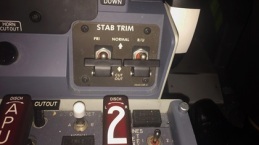
.
.
This drawing below shows the function of the STAB TRIM cutout switches on the Boeing 737 NG family of aircraft. (source).
It clearly shows each of the two switches has a different function.
The MAIN ELECT cutout switch – deactivates stabilizer trim switch operation operated by the pilot via control column switch
The AUTOPILOT cutout switch – deactivates autopilot stabilizer trim operation. Autopilot disengages if engaged.The switches are provided to allow the autopilot or main electric trim inputs to be disconnected from the stabilizer trim motor. The STAB TRIM MAIN ELECT cutout switch and the STAB TRIM AUTOPILOT cutout switch, located on the control stand, are provided to allow the autopilot or main electric trim inputs to be disconnected from the stabilizer trim motor.” They are wired in parallel.The STAB TRIM OVRD (Override) switch is located all the way at the bottom of the pedestal panel.STAB TRIM OVERRIDE switch
NORMAL
– normally guarded to ensure normal operation of the column actuated cutout switch
OVERRIDE
– bypasses the column cutout switches (if both fail)
– restores power to the stabilizer trim switches
– when this switch is placed in override, the main electric trim will operate when commanded regardless of control column position because the column cutout switches are bypassed
– if the stab is jammed you may be up against the column cutout switch (opposite force)
– use STAB TRIM OVRD switch to enable use of main electric stab trim again
– operational test of column cutout switches and OVRD switch:
– do this at the gate during your preflight
– while trimming with electric stab trim, oppose the trim by moving the column in the opposite direction
– column cutout switches should engage, stopping the electric stab trim input
– move the stab trim OVRD switch to OVRD
– trim should resume
The procedure as documented in the Quick Reference Handbook (QRH) for the Boeing NG for a runaway stabilizer is to cutout both STAB TRIM switches. This is demonstrated in this video. The same will apply for the MAX.
Boeing 737 MAX cutout switches
This drawing shows the electrical scheme of the MAX. A and B are the cutout switches. See the MCAS Engage label on the bottom om the diagram indicating this is a MAX scheme.
Seattle Times reported about the changed function of the cutout switches at May 10.- Not informing pilots about the disappearance of the ‘auto-pilot electric stab trim cutout switch’ which was available on the NG series. Boeing just stated in the iPad training a ‘change of nomenclature’ of the switches.The Flight Standardization Board (FSB) took notice of the nomenclature change of the cutout switches but did not make any mention of the difference in responding to autopilot stab trim runaway. On the 737NG, the flight crew retain electric trim; on the 737MAX the flight crew must use manual trim. It turns out, this is a significant difference in pilot workload and pilot capacity to fly the airplane.
What is remarkable is the redudancy of the cutout switches. So while MCAS uses a single AOA-sensor with no redundancy, the cutout switch has redudancy.
- Deleting the roller coaster recovery procedure (also known as yoyo ) from the flight crew operating manual. It was part of at least manuals used for the early Boeing 737-100 and -200 series. This procedure can be used if other methods (like manual trim) fail to relieve the elevator load and control column force.
Explained at the Theaircurrent.com
- Boeing revealed the software used on the Max training simulator was unable to reproduce some flight conditions, including the conditions which led to the crash of Ethiopian Airlines flight ET302 on March 10. Boeing made changes to the software which will improve the simulation of force loads on the manual trim wheel. Mind regulators did not require training in a Max simulator and there is only one Max simulator in North America: at Air Canada. (source)
FAA EMERGENCY AIRWORTHINESS DIRECTIVE
After the Lion Air crash the FAA issued on the 7th of November 2018 an emergency airworthiness Directive (AD). It explains to pilots that in case the horizontal stabilizer is commanded down, the pilots should use the cutoff switches to make sure electric trim is not possible anymore.
The FAA AD issued 7th November is a carbon of Boeing TBC-19 issued 6th November. However, suspect they colluded as to the instruction and its wording.
However FAA should make it clear that before using the cutoff switchs, the plane should be trimmed using the trim switches on the yoke such that all trim command are given with less than 5 seconds interval, otherwise MCAS will kick in and commands the nose down.
Pilot error ??
This image shows the altitude of ET302 and the various events as wel on the horizontal axis the time. The image makes clear the aircraft was climbing. Just before the final downward nose angle, the crew set the STAB TRIM switches back to the normal position. This is against the Boeing runaway stabilizer procedure. Enabling trim enabled MCAS again.
The ET302 crash is a typical example of the Swiss cheese model. When all holes are aligned an accident will happen. Boeing made error, the FAA made errors. And the crew actions are questionable.

Why did the crew try to engage the autopilot? Why didn’t they rely on the the IAS data on the first officer side?
Answer: it could be the pilots knew that MCAS can be disabled by engaging the autopilot. Just after take off the left AOA-sensor provided incorrect data while the stick shaker became active. However, If he knew enough about MCAS to know that it doesn’t operate when autopilot is on, he would presumably also know it doesn’t operate with flaps extended. Also if that it what he was thinking, then that implies he knew that the stall warning was false? If the crew thought it was a stall, then the stall recovery should have been implemented – it was not and in fact they (Ethiopian) tried to engage the autopilot, a definite no-no in a stall.
Soon after the crew engaged the autopilot, it was automatically disengaged. Likely because AP disengage when AoA disagree. That leaves the question if the crew was aware the IAS was incorrect on the captain side due to a failure of the AOA-sensor. They could have flown the aircraft manually on the instruments of the first officer, trim the aircraft using the manual trim on the yoke and make sure after in trim use the cutout switches to disable electic trimming of the stabilzer.
Why did the First Officer state that manual trimming did not work? Wasn’t he able to manualy turn the wheel because of forces on the elevator made movement of the stabilizer impossible? Or did the FO expect a direct result after turning the wheel? The wheel needs to be turned many times to have a change in units.
After the crew found out manual trim using the wheel was ‘not working’ the electric trim cutoff switches were put back to ON. The crew used two short burst of Nose Up. However, after that MCAS gave the fatal nose down commands. Why didn’t the crew use the switches on the yoke to trim the aircraft?
At 05:40:35, the First-Officer called out “stab trim cut-out” two times. Captain agreed and First-Officer confirmed stab trim cut-out. At 05:41:46, the Captain asked the First-Officer if the trim is functional. That is a strange question as the captain should have knows electric trim was disabled. It could be the captain believed the auto-pilot STAB TRIM was set to disabled (as possible in the NG serie).
When the data of the FDR is studied, some strange data is seen on the blue ‘AP Warn Capt’ line. At 05:4315 there is a ‘autopilot disconnect warning’. Pilots get this warning when autopilot has disengaged. or when an autopilot engage attempt is made and is unsuccessful.
The first two warnings (around 05:38:50) were because of the unsuccessful attempts to engage the autopilot at around 400 feet. The third warning (at 03:39:55) was when it was disconnected after about 30 seconds on autopilot.
But there is also a fourth warning at 05:43:15, right after they made those two quick trim inputs. It certainly looks like they made a failed attempt to engage the autopilot here.
Why did the crew tried to enable the autopilot? Did they turn the trim cutout switches back on so they could reengage the autopilot, hoping the automation would sort out their problems? Or did the crew remember that MCAS cannot be active when autopilot is engaged?
And the main question: Why didn’t the crew reduce power so speed would decrease? Was the crew in panic because of the stick shaker? A decrease in speed would make manual trimming using the wheel easier. Was the crew occupied by the stickshaker, the warnings of closing in to the ground and too much focused on getting the nose up again?
Unconfirmed
Another possible issue would be related to the Stabilizer Trim Motor (STM). This motor is manufactured by a firm called Eaton. The STM has two speed modes for the autopilot and main electric trim, I.e. high rate trimming with flap extended and low rate trimming with flap up.
Is the MCAS programmed to always input high rate trimming? Hence if you are flying a MAX with flap up and the MCAS puts in a high rate AND burst for 10sec, then the pilots available ANU counter response on the main electric trim will only be at the low rate.
BTW; MCAS commanding AND last for maximum 10 seconds. It can be overriden by the pilots using the manual trim ANU using the switch on the yoke. It is unclear why the crew did not override MCAS in the final phase of the flight.
Manual trim aircraft nose down direction! Why?
At 05:40:35, the First-Officer called out “stab trim cut-out” two times. Captain agreed and First-Officer confirmed stab trim cut-out
From 05:40:42 to 05:43:11 (about two and a half minutes), the stabilizer position gradually moved in the AND direction from 2.3 units to 2.1 units
The MAX horizontal stabilizer range is from “0 units” to “17 units”. 0.0 to 4.2 units is nose DOWN. 4.2 to 17.0 is nose UP
So the motor of the stabilzer was not operational anymore as result of cutout switches. Still the stabilizer moved nose down direction. How could this be possible? A possible answer was given on airliners.net
Given that the trim moved such a small amount, I suspect that this was due to the pilots trying very hard to use the manual wheel to move the trim ANU. It could be that every time they tried pushing the wheel in the ANU direction, and then released the pressure when nothing happened, the tension in the system caused a slight bounce back in the opposite direction, partly due to the very slight springiness inherent in even the best cables, and partly due to the forces on the elevator, which are opposing.ANU adjustments, but will assist movement in the AND direction.
Another possibility
There was even a video (not the removed one) where copilot was trying to move the stabilizer by winding the wheel in other direction to get more momentum to “slam” it in direction he wanted to move it.Perhaps they assumed the stabilizer was stuck due to screw malfunction or something similar and tried repeatedly to slam it to release it.
Questions on the effect of electric trim under high speed conditions
It appears that the electric trimming was not allowing, or unable to trim further nose up, for reason(s) we are not able to comprehend at this point
And we see this behavior repeatedly in the FDR traces: from the moment the flaps are up, every electric nose up trimming stops way before the aft column force is balanced out. Why would a pilot stop nose up trimming, if he is pulling with most/if not all of his strength on the column? It just does not make any sense whatsoever. There must be some mechanism behind that, and I refuse to accept – without solid evidence – that that mechanism is crew/training related. (taken from airliners.net)
This EASA document related to the Boeing B737-7/-8/-9 states that thumb switch trim does not have enough authority to completely trim the aircraft.
Simulation has demonstrated that the thumb switch trim does not have enough authority to completely trim the aircraft longitudinally in certain corners of the flight envelope, e.g. gear up/flaps up, aft center of gravity, near Vmo/Mmo corner, and gear down/flaps up, at speeds above 230 kts
The EASA document refers to the designed limits for electric trim, that do not allow you to trim electrically outside its designed range, even though the range available with mechanical trim is larger, and in some situations you need to access a larger range than manual electric trim allows. Those design limits don’t apply when you trim electrically ANU to counter MCAS. They would only apply if you would try to trim further AND electrically, after you reached the AND design limit for manual electric trim (lower than 3.95 units on the 737-800, for example). The opposite direction, ANU, would be unaffected and should work just fine, even when you are trimmed AND outside the designed range for manual electric trim.
Stabilizer trim
Taken from pprune.org . The text explains in which scenario high speed trim and low speed trim are used.
Stab trim does go through a gearbox, between motor and jackscrew, and there are at least two clutches (nose up/down – not sure if ap/manual is also separate or is a speed change).
From NG AMM chapter 27:
When the flaps are up, the switch is open and low speed trim is engaged. Low speed trim moves the stabilizer at 0.2 units per second. When the flaps are not up, the switch closes and sends a signal to the stabilizer trim actuator to engage high speed trim. High speed trim moves the stabilizer at 0.4 units per second.
During autopilot operation, the stabilizer trim speed changes. When the flaps are up, the low speed trim is0.09 units per second. When the flaps are not up, the high speed trim is 0.27 units per secondWhat is also known is that MCAS trims at the flaps down autopilot speed – i.e. the “High speed”. I don’t know if this was a change at some stage due to finding low speed was insufficient for certification – it might have been. I also know how it was implemented (which is as I guessed it might be) – by blocking the flaps-up signal on MCAS engage.
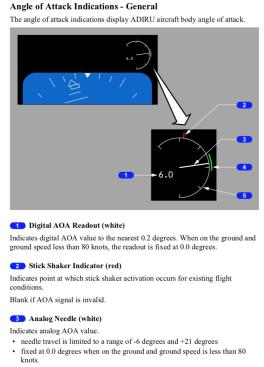

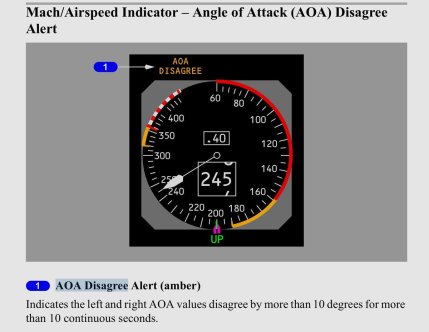
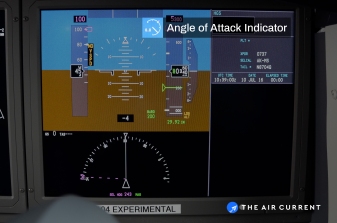
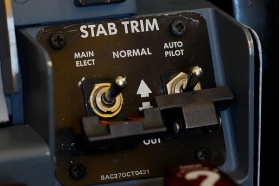

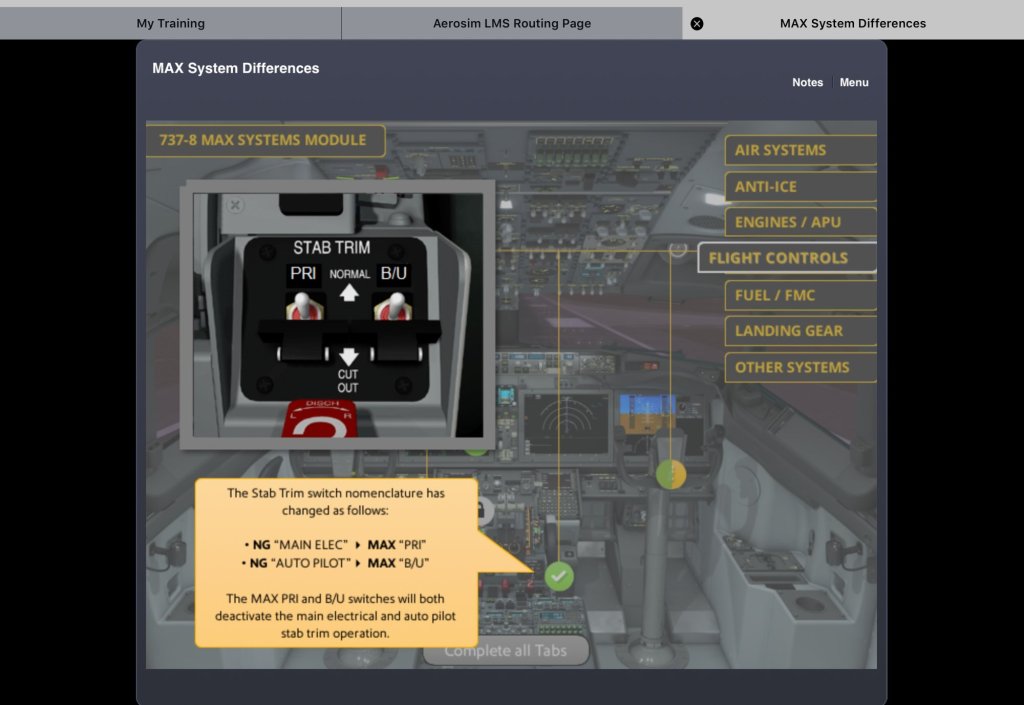

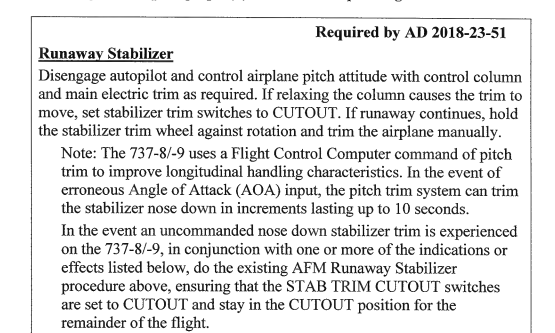


A possible, or even likely, reason for using the single sensor can be found in the origin of MCAS. It was necessary to compensate for the aerodynamic changes resulting from the new engine size and placement. In certain sensor failure modes, the either/or configuration gives the highest probability that MCAS will work properly. But the either/or arrangement will also result in a higher probability of erroneous activation of MCAS. In other words, the change to “use both sensors” may leave the aircraft more susceptible to other types of failures. For example: If, in the proposed configuration, one of the sensors fails to a neutral position (it gets stuck at 0 degrees), that failure, in a two out of two voting arrangement, will disable the ability to detect stall conditions, which is the principle safety function of MCAS. The “solution” may reduce the chances of erroneous MCAS activation, but it also reduces the chances of detecting stall. In changing the voting configuration, Boeing is implicitly arguing that erroneous activation of MCAS is of more concern than performing its principle function.
LikeLike
Great article but I believe the roof cause is still there. I believe the roof cause is FAA doesn’t require an independent software airworthiness certification.
MCAS was one software failure and once it is fixed along with other fixes the MAX is safe to fly again. Of course not. Not when they fix symptoms. Not when FAA still allows Boeing self-certifies software. One example Boeing allowed MCAS to take only one input from a sensor. From a safety engineering point of view one input was a single point of failure. So when the sensor malfunctioned and produced a garbage input to MCAS then MCAS produced a garbage output. This is called garbage in garbage out. There could be many garbage in garbage out haven’t uncovered. Like MCAS was one phantom code no one knew existed. But there could be many other phantom codes in the one or two million lines of code and some day under some freak event some of these phantom or dead code may be activated accidentally on its own and it becomes a ghost code to fly a plane again. And on the still missing Malaysia plane no experts have mentioned a software angle. It was possible a ghost code did it and not the pilot like those experts had concluded. Just a thought.
FAA has a point that it doesn’t have manpower to certify a couple million lines of code. But FAA can be creative and ask Congress for more funding and then FAA can allocate part of its annual budget to create an independent software company to do software airworthiness certification. This increases public confidence. This isn’t a new concept. The Air Force has done something, i.e. it allocates a few hundred millions per year to create the Aerospace company to oversee and independently verify and validate products the Air Force procures from defense contractors.
LikeLike